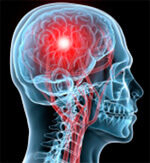Stroke Facts
Risk Factors and Warning Signs
Anyone can have a stroke at any age. Your chance of having a stroke increases if you have certain risk factors. Some risk factors for stroke can be changed or managed, while others can’t.
Risk factors for stroke that can be changed, treated, or medically managed:
- High blood pressure.
- Heart disease.
- Diabetes.
- Smoking.
- Birth control pills (oral contraceptives).
- History of TIAs (transient ischemic attacks).
- High red blood cell count.
- High blood cholesterol and lipids.
- Lack of exercise.
- Obesity.
- Excessive alcohol use.
- Illegal drugs.
- Abnormal heart rhythm.
- Cardiac structural abnormalities.
Risk factors for stroke that can’t be changed:
- Older age.
- Race.
- Gender.
- History of prior stroke.
- Heredity or genetics.
F.A.S.T. is an easy way to remember the signs of a stroke. When you see these signs, you will know that your need to call 911 fast. In the event of a stroke, time saved = brain saved.
- F – Face Drooping: One side of the face is drooping or numb. When the person smiles, the smile is uneven.
- A – Arm Weakness: One arm is weak or numb. When the person lifts both arms at the same time, one arm may drift downward.
- S – Speech Difficulty: You may hear slurred speech or see difficulty speaking. The person can’t repeat a simple sentence correctly when asked.
- T – Time to Call 911: If someone shows any of these symptoms, call 911 right away. Call even if the symptom goes away. Make note of the time the symptoms first appeared.
You can help prevent stroke by making healthy lifestyle choices. A healthy lifestyle includes the following:
- Eating a healthy diet.
- Maintaining a healthy weight.
- Getting enough exercise.
- Not smoking.
- Limiting alcohol use.
- Taking medication as prescribed.
Click here to learn more about adapting a healthy lifestyle.
Stroke FAQs
 Stroke is a leading cause of death and a leading cause of serious, long-term
disability, according to the American Heart Association (AHA) and the
American Stroke Association (ASA). The ASA reports that strokes are the
fifth leading cause of death in the U.S.
Stroke is a leading cause of death and a leading cause of serious, long-term
disability, according to the American Heart Association (AHA) and the
American Stroke Association (ASA). The ASA reports that strokes are the
fifth leading cause of death in the U.S.
A stroke occurs when the flow of oxygen-rich blood is blocked to a portion of the brain. The brain needs a constant supply of oxygen and nutrients in order to work well. If blood supply is stopped even for a short time, this can cause brain cells to die. Also, sudden bleeding in the brain can cause a stroke. The two main types of stroke are ischemic and hemorrhagic.
Click here to learn more.An ischemic stroke occurs when a blood vessel that supplies the brain becomes blocked or "clogged" and impairs blood flow to part of the brain. The brain cells and tissues begin to die within minutes from lack of oxygen and nutrients. The area of tissue death is called an infarct. About 87% of strokes fall into this category.
Hemorrhagic strokes occur when a blood vessel that supplies the brain ruptures and bleeds. When an artery bleeds into the brain, brain cells and tissues do not receive oxygen and nutrients. In addition, pressure builds up in surrounding tissues and irritation and swelling occur, which can lead to further brain damage. About 13% of strokes are caused by hemorrhage.
Click here to learn more about Hemorrhagic Stroke with an informative video.
A transient ischemic attack (TIA), also called a ministroke or warning stroke, causes symptoms similar to those of a stroke. The difference is that TIAs don’t cause permanent brain damage. TIAs happen when a blood clot or artery spasm suddenly blocks or closes off an artery briefly. This stops blood from reaching a part of the brain for a short period of time. A TIA is a medical emergency and you should call 911, even if your symptoms resolved.
Click here to watch a video about TIAs and the warning signs.
